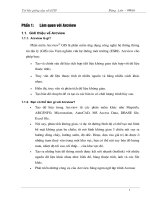Tài liệu giảng dạy CCNA - module 03 chapter 11-Advanced Routing Protocol Topics
Bạn đang xem bản rút gọn của tài liệu. Xem và tải ngay bản đầy đủ của tài liệu tại đây (383.75 KB, 29 trang )
1
Module 03 Routing Protocol
Chapter 11
Advanced Routing Protocol Topics
2
Table of Content
1
Route Summarization and Variable-Length Subnet Masks
2
Classless Routing Protocols and Classless Routing
3
1. Route Summarization and
Variable-Length Subnet Masks
4
Issues with IP Addressing
IP addressing crisis
As early as 1992, the IETF identified two specific concerns:
IP address exhaustion
Routing table growth
U N I V E R S I T Y
U N I V E R S I T Y
Internet
5
IP Addressing Solutions
Short term to extension to IPv4
Subneting masking: RFCs 950, 1812
Variable-length subnet masks: RFC 1812
Classless interdomain routing: RFCs 1518,
1519, 2050
Address allocation for private Internets: RFC
1918
Network Address Translation: RFC 1631
Route summarization: RFC 1518
Ultimate solution: IPv6 128-bit address
space
6
What is VLSM ?
Subnet 172.16.14.0/24 is divided into smaller subnets (Sub-
subnet):
Subnet with one mask at first (/27)
Further subnet one of these subnets not used elsewhere (/30)
172.16.0.0/16
172.16.14.32/27
172.16.14. 64/27
172.16.14.96/27
C
B
A
HQ
172.16.1.0/24
172
.16.
2.0/
24
HQ
172.16.14.136/30
172.16.14.132/30
172.16.14.140/30
7
VLSM is supported
Open Shortest Path First (OSPF).
Integrated Intermediate System to Intermediate System
(Integrated IS-IS).
Enhanced Interior Gateway Routing Protocol (EIGRP).
RIP v2.
Static routing.
8
A waste of space
9
When to use VLSM?
10
Calculating subnets with VLSM
11
Calculating subnets with VLSM (2)
Derived from the
172.16.32.0/20 Subnet
172.16.33.0/30
172.16.32.0/26
172.16.32.64/26
172.16.32.128/26
172.16.32.192/26
26-Bit Mask (62 Hosts)
Derived from the
172.16.33.0/26 Subnet
30-Bit Mask (2 Hosts)
172.16.33.12/30
172.16.33.8/30
172.16.33.4/30
12
Exercise Calculating subnets with
VLSM
60 Hosts 12 Hosts 12 Hosts
Using VLSMs, define appropriate subnets for addressing
the networks using 192.168.10.0/24.
28 Hosts
KL
Sydney
Perth
Singapore
13
Exercise Calculating subnets with
VLSM
60 Hosts 12 Hosts 12 Hosts
192.168.10.0/24
KL
Sydney
Perth
Singapore
192.168.10.64/27
192.168.10.128/30
192.168.10.132/30
192.168.10.136/30
28 Hosts
192.168.10.0/26 192.168.10.96/28 192.168.10.112/28
14
Route aggregation with VLSM
KL
Sydney
Perth
Singapore
192.168.48.0/24
192.168.49.0/24
192.168.50.0/24
192.168.51.0/24
192.168.52.0/24
192.168.53.0/24
192.168.54.0/24
192.168.55.0/24
192.168.56.0/24
192.168.57.0/24
192.168.63.0/24
1
9
2
.
1
6
8
.
5
6
.
0
/
2
1
192.168.52.0/22
1
9
2
.
1
6
8
.
4
8
.
0
/
2
0
192.168.48.0/22
Upstream
provider
Upstream
provider
Route summarization reduces routing table size by
aggregating routes to multiple networks into one
supernet
15
Route summarization example
16
Configuring VLSM
192.168.10.112/28
60 Hosts 12 Hosts 12 Hosts
192.168.10.0/24
KL
Sydney
Perth
Singapore
192.168.10.64/27
192.168.10.128/30
192.168.10.132/30
192.168.10.136/30
28 Hosts
192.168.10.0/26 192.168.10.96/28
S0
10.137
S0 10.137
17
2. CLASSLESS ROUTING
PROTOCOLS AND CLASSLESS
ROUTING
18
Classless and Classful Routing
Protocols
Classful routing protocols do not transmit the mask
information along with the subnet number.
Classless routing protocols do transmit mask information.
They support some advanced features such as VLSM and
summarization.
19
Autosummarization
When a router has interfaces in more than one Class A, B,
or C network, it advertises a single route for an entire Class
A, B, or C network into the other network. This feature is
called autosummarization.
When advertised on an interface whose IP address is not in
network X, routes related to subnets in network X are
summarized and advertised as one route. That route is for
the entire Class A, B, or C network X.
Classful routing protocols perform autosummarization by
default.
20
Autosumarization
Subnet mask: 255.255.255.0
10.3.4.0
10.3.5.0
10.3.6.0
10.3.7.0
172.16.3.0
172.16.1.0
I only know about
network 10.0.0.0 –
No subnets!
21
Autosummarization Pitfalls
10.3.4.0
10.3.5.0
10.3.6.0
10.3.7.0
172.16.3.0
172.16.1.0
Which route to
network 10.0.0.0
do I believe ?
10.2.1.0
10.2.2.0
10.2.3.0
10.2.4.0
172.16.1.0
Subnet mask: 255.255.255.0
22
Default route
Rest Net
Frame Relay
168.13.100.0
168.13.1.0/24
168.13.2.0
168.13.3.0
Dist 1
R 1
R 2
R 3
168.13.100.1
10.1.1.1
168.13.1.1
168.13.100.1
23
Ip route command
R1(config)# ip route 0.0.0.0 0.0.0.0 168.13.1.101
R1# show ip route
Codes: C - connected, S - static, I - IGRP, R - RIP, M - mobile, B - BGP
D - EIGRP, EX - EIGRP external, O - OSPF, IA - OSPF inter area
N1 - OSPF NSSA external type 1, N2 - OSPF NSSA external type 2
E1 - OSPF external type 1, E2 - OSPF external type 2, E - EGP
i - IS-IS, L1 - IS-IS level-1, L2 - IS-IS level-2, ia - IS-IS inter area
* - candidate default, U - per-user static route, o - ODR
P - periodic downloaded static route
Gateway of last resort is 168.13.1.101 to network 0.0.0.0
168.13.0.0/24 is subnetted, 4 subnets
C 168.13.1.0 is directly connected, TokenRing0
R 168.13.3.0 [120/1] via 168.13.100.3, 00:00:05, Serial0.1
R 168.13.2.0 [120/1] via 168.13.100.2, 00:00:21, Serial0.1
C 168.13.100.0 is directly connected, Serial0.1
S* 0.0.0.0/0 [1/0] via 168.13.1.101
24
Ip route command (cont.)
R3# show ip route
Codes: C - connected, S - static, I - IGRP, R - RIP, M - mobile, B - BGP
D - EIGRP, EX - EIGRP external, O - OSPF, IA - OSPF inter area
N1 - OSPF NSSA external type 1, N2 - OSPF NSSA external type 2
E1 - OSPF external type 1, E2 - OSPF external type 2, E - EGP
i - IS-IS, L1 - IS-IS level-1, L2 - IS-IS level-2, ia - IS-IS inter area
* - candidate default, U - per-user static route, o - ODR
P - periodic downloaded static route
Gateway of last resort is 168.13.100.1 to network 0.0.0.0
168.13.0.0/24 is subnetted, 4 subnets
R 168.13.1.0 [120/1] via 168.13.100.1, 00:00:13, Serial0.1
C 168.13.3.0 is directly connected, Ethernet0
R 168.13.2.0 [120/1] via 168.13.100.2, 00:00:06, Serial0.1
C 168.13.100.0 is directly connected, Serial0.1
25
Ip default-network command
R1(config)# ip default network 10.0.0.0
R1(config)# exit
R1# show ip route
Codes: C - connected, S - static, I - IGRP, R - RIP, M - mobile, B - BGP
D - EIGRP, EX - EIGRP external, O - OSPF, IA - OSPF inter area
N1 - OSPF NSSA external type 1, N2 - OSPF NSSA external type 2
E1 - OSPF external type 1, E2 - OSPF external type 2, E - EGP
i - IS-IS, L1 - IS-IS level-1, L2 - IS-IS level-2, ia - IS-IS inter area
* - candidate default, U - per-user static route, o - ODR
P - periodic downloaded static route
Gateway of last resort is 168.13.1.101 to network 10.0.0.0
168.13.0.0/24 is subnetted, 5 subnets
R 168.13.200.0 [120/1] via 168.13.1.101, 00:00:12, TokenRing0
C 168.13.1.0 is directly connected, TokenRing0
R 168.13.3.0 [120/1] via 168.13.100.3, 00:00:00, Serial0.1
R 168.13.2.0 [120/1] via 168.13.100.2, 00:00:00, Serial0.1
C 168.13.100.0 is directly connected, Serial0.1
R* 10.0.0.0/8 [120/1] via 168.13.1.101, 00:00:12, TokenRing0









